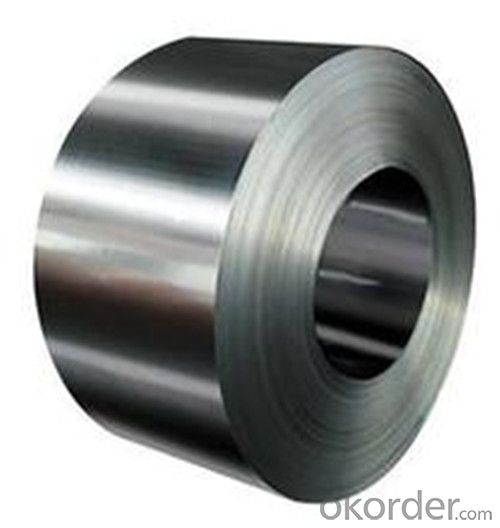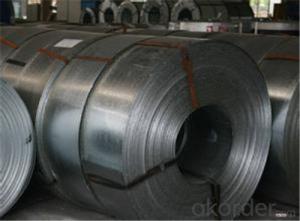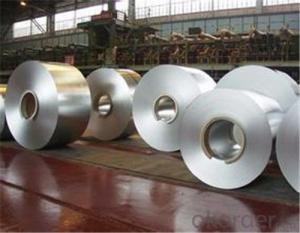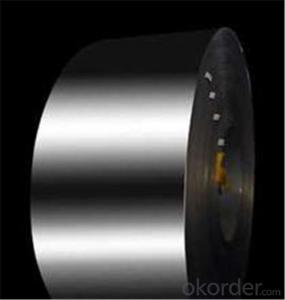Rolled Steel Sheet / Plate in CNBM from China
- Loading Port:
- Tianjin
- Payment Terms:
- TT OR LC
- Min Order Qty:
- 200 m.t.
- Supply Capability:
- 5000000 m.t./month
OKorder Service Pledge
OKorder Financial Service
You Might Also Like
Description:
The raw material of cold rolled steel coil/sheet is high quality hot rolled product, and after pickling, kinds of new technology and new process of global cold rolling production have been applied. Therefore the manufacturing, home appliance, automobile etc.
Specification:
COLD ROLLED STEEL | |
Thicknenss | 0.10mm-4.00mm |
Width | 600mm-2000mm |
Sheets length | 1200-6000mm |
Coil inner diameter | 508-610mm |
Surface treatement | matt finish/bright finish,oiling/dry, bright anneal/black anneal |
Coil weight | 3-5t |
Characteristic:
Quality of the goods could be guaranteed. The finished product has a variety of excellent capabilities, such as continuous rolling, degreasing, annealing, skin pass, slitting and cut to length line etc. Along with it many rocessing capability and smooth, flat surface. It’s widely used in outdoor and interior decoration, furnishing
Details:
We can ensure that stable quality standards are maintained, strictly meeting both market requirements and customers’ expectations. Our products enjoy an excellent reputation and have been exported to Europe, South-America, the Middle-East, Southeast-Asia, Africa and Russia etc.. We sincerely hope to establish good and long-term business relationship with your esteemed company.
Images:

FAQ
1.What's your MOQ?
50MT, it is for one container.
2.Whether your company have QC teams?
Yeah, sure, our QC team is very important, they will keep the quality control for our products.
3. What's your normal delivery time?
Our delivery time about 10-20days for standard sizes, if you have other requirements like hardness and width ,it is about 20-40days. But don't worry ,we also try our best for the
- Q:What are the different types of steel coil cuts?
- There are several different types of steel coil cuts, including hot-rolled, cold-rolled, galvanized, and stainless steel coil cuts.
- Q:What are the different methods of coil cutting for steel coils?
- There are several methods of coil cutting for steel coils, including slitting, shearing, and laser cutting. Slitting involves passing the coil through a set of circular blades to create multiple narrower strips. Shearing utilizes a straight blade to cut the coil into desired lengths. Laser cutting involves using a high-powered laser beam to precisely cut through the coil. Each method has its own advantages and is chosen based on the specific requirements and preferences of the manufacturer or end-user.
- Q:What are the different methods of edge camber correction for steel coils?
- There are several methods used for edge camber correction in steel coils, depending on the specific requirements and equipment available. Some of the common methods include: 1. Mechanical Edge Trimming: This method involves trimming the edges of the coil using mechanical tools such as shears or slitters. It helps to remove excess material and correct the camber. This method is often used for smaller coils or when the camber is minimal. 2. Tension Leveling: Tension leveling is a process where the coil is passed through a series of adjustable rollers under tension. The tension helps to elongate the steel and reduce the camber. This method is effective for correcting moderate camber and is commonly used for larger coils. 3. Roller Leveling: Roller leveling is similar to tension leveling, but instead of adjustable rollers, the coil is passed through a series of fixed rollers. These rollers exert pressure on the steel to flatten it and correct the edge camber. This method is often used for thicker and heavier coils. 4. Heat Straightening: Heat straightening involves applying controlled heat to the edges of the coil to soften the steel. Once the steel becomes malleable, external force is applied to straighten the edges. This method is suitable for correcting severe edge camber but requires specialized equipment and expertise. 5. Combination Methods: In some cases, a combination of different methods may be used to achieve the desired edge camber correction. For example, mechanical edge trimming may be followed by tension leveling or roller leveling to further straighten the edges. It is worth mentioning that the choice of method depends on various factors such as the severity of camber, coil dimensions, material properties, and available equipment. It is essential to evaluate these factors and consult with experts to determine the most suitable method for edge camber correction in steel coils.
- Q:How are steel coils used in the production of marine vessels?
- Steel coils are used in the production of marine vessels primarily for their strength, durability, and corrosion resistance. These coils are shaped and formed into various components such as hulls, decks, and bulkheads, providing a sturdy framework for the entire vessel. By utilizing steel coils, marine vessels gain the necessary structural integrity to withstand harsh marine environments and ensure the safety and reliability of the vessels.
- Q:Can steel coils be used in the production of packaging materials?
- Certainly, packaging materials can indeed utilize steel coils. Frequently, steel coils serve as the primary material in packaging items like metal strapping and steel banding. These coils possess remarkable strength, durability, and exceptional tensile strength, rendering them perfectly suitable for effectively securing and safeguarding diverse products throughout their transportation and storage. Furthermore, steel coils can be effortlessly molded and fashioned into various packaging elements, guaranteeing a dependable and secure packaging solution for an extensive array of industries.
- Q:What are the common methods of recoiling steel coils?
- There are several common methods of recoiling steel coils, depending on the specific requirements and preferences of the manufacturer or customer. One common method is known as slitting, which involves cutting the wide steel coil into narrower strips. This is achieved by passing the coil through a set of rotating circular blades that cut the steel into multiple smaller coils with desired widths. Slitting is commonly used to create coils of different sizes for various applications. Another method is called cut-to-length (CTL) recoiling, where the steel coil is cut into specific lengths as per the customer's requirements. This process involves feeding the coil through a straightening and leveling machine, followed by a flying shear that cuts the steel into desired lengths. CTL recoiling is often used in industries where precision and uniformity of steel lengths are crucial, such as construction or automotive. Additionally, there is a method called coil-to-coil recoiling, which involves rewinding the steel coil onto a new coil, with the desired dimensions and properties. This process is commonly used when the original coil needs to be resized, reconditioned, or rerolled for further processing or transportation purposes. Coil-to-coil recoiling is often done using specialized recoiling machines that ensure the proper tension, alignment, and winding of the steel coil onto the new coil. Overall, the common methods of recoiling steel coils include slitting, cut-to-length (CTL) recoiling, and coil-to-coil recoiling. Each method offers its own advantages and is chosen based on factors such as required coil dimensions, precision, efficiency, and the specific needs of the industry or customer.
- Q:What are the dimensions of steel coils used in the automotive industry?
- The dimensions of steel coils used in the automotive industry can vary depending on the specific application and requirements. However, typical dimensions for steel coils used in the automotive industry range from 0.5mm to 3mm in thickness and from 500mm to 2000mm in width. The length of the coils can vary depending on the production process and customer specifications. Additionally, the weight of the coils can range from a few hundred kilograms to several tons. It is important to note that these dimensions are general guidelines and can vary depending on the specific needs of the automotive manufacturer.
- Q:I also heard Stainless holds up better againts rust, blue steel needs more care.
- They have different properties. Bluing on steel is a surface treatment that helps inhibit rust, but doesn't prevent it. It will wear off with use over time, but can be redone. Stainless steel refers to a particular type of steel alloy, usually incorporating nickel and chromium, that is highly resistant to rust on its own, so doesn't need a surface treatment. Because the steel itself is what is rust resistant, that property can't wear off. All other things held equal, the carbon steel that bluing is typically applied to tends to be slightly more rigid and brittle than stainless steel. It may hold an edge better than stainless. In most applications, those differences are small enough not to matter for practical purposes. For example, both knives and guns are made with blued steel and stainless steel. Which a person gets is usually a matter of preference (unless you're, say, a professional restaurant chef whose knives have to hold a fine edge through constant hard use).
- Q:How do steel coils compare to aluminum coils?
- Steel coils and aluminum coils have several key differences that make them suitable for different applications. Firstly, steel coils are known for their strength and durability. They can withstand high temperatures and are less prone to damage compared to aluminum coils. This makes steel coils ideal for heavy-duty industrial applications that require robust materials, such as construction, automotive manufacturing, and oil and gas industries. Steel coils are also more resistant to corrosion, making them suitable for outdoor use in harsh environments. On the other hand, aluminum coils are lighter and have a higher strength-to-weight ratio compared to steel coils. This makes them perfect for industries where weight is a critical factor, such as aerospace and transportation. Aluminum coils are also more malleable, allowing for easier shaping and forming, which is advantageous in industries like packaging and consumer electronics. Moreover, aluminum coils have better thermal conductivity than steel coils, which makes them more efficient in heat transfer applications. This property is beneficial in industries like HVAC (heating, ventilation, and air conditioning) and refrigeration, where efficient heat exchange is crucial. In terms of cost, steel coils are generally more affordable compared to aluminum coils due to the lower cost of raw materials. However, aluminum coils can offer long-term cost savings as they require less maintenance and have a longer lifespan due to their resistance to corrosion. In conclusion, the choice between steel coils and aluminum coils depends on the specific requirements of the application. Steel coils are preferred for their strength, durability, and corrosion resistance, while aluminum coils excel in lightweight applications, heat transfer, and malleability.
- Q:How are galvanized steel coils different from regular steel coils?
- Galvanized steel coils are different from regular steel coils as they are coated with a layer of zinc to prevent corrosion and rust formation. This zinc coating acts as a protective barrier, increasing the longevity and durability of the steel coils, especially in harsh environmental conditions.
1. Manufacturer Overview |
|
|---|---|
| Location | |
| Year Established | |
| Annual Output Value | |
| Main Markets | |
| Company Certifications | |
2. Manufacturer Certificates |
|
|---|---|
| a) Certification Name | |
| Range | |
| Reference | |
| Validity Period | |
3. Manufacturer Capability |
|
|---|---|
| a)Trade Capacity | |
| Nearest Port | |
| Export Percentage | |
| No.of Employees in Trade Department | |
| Language Spoken: | |
| b)Factory Information | |
| Factory Size: | |
| No. of Production Lines | |
| Contract Manufacturing | |
| Product Price Range | |
Send your message to us
Rolled Steel Sheet / Plate in CNBM from China
- Loading Port:
- Tianjin
- Payment Terms:
- TT OR LC
- Min Order Qty:
- 200 m.t.
- Supply Capability:
- 5000000 m.t./month
OKorder Service Pledge
OKorder Financial Service
Similar products
New products
Hot products
Related keywords





























